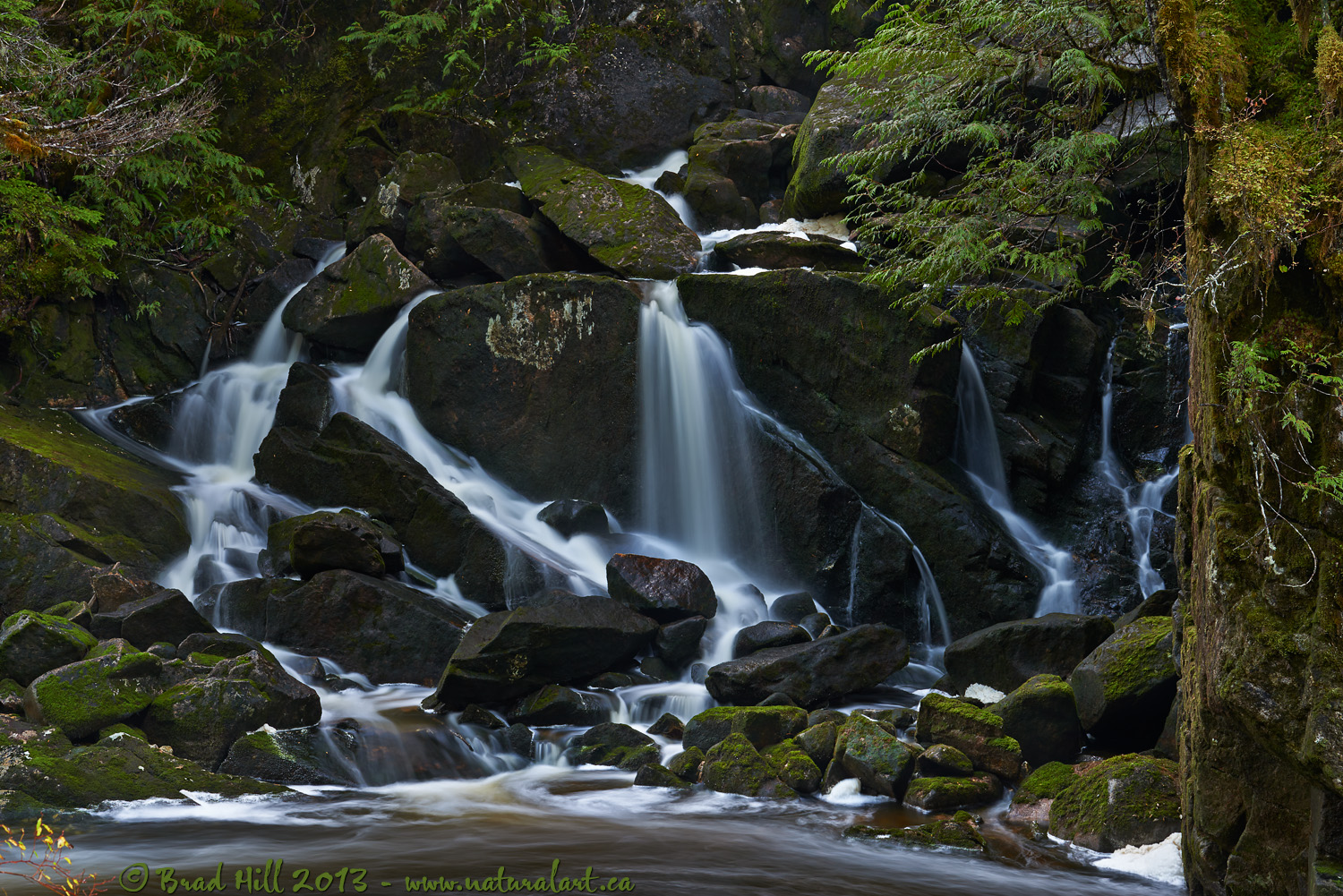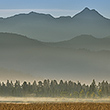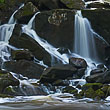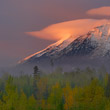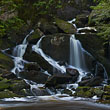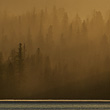Availability: Undetermined - Enquiries?
In the Field
Undiscovered. Great Bear Rainforest, BC, Canada. October 15, 2013.
During the autumn of 2013 I ran my first "Exploratory Photo Adventure" trip into the Great Bear Rainforest. Unlike my other photo tours into the Great Bear, this one differed in that exploration of rarely visited or hard-to-access locations took precedence over "bagging" photos of any particular subject matter. So rather than investing time searching specifically for things like Spirit Bears or Grizzlies, we explored inlets and drainages - looking for whatever we found (which, of course, lead to a success rate of 100% in achieving our goal). More often than not this involved bushwhacking, stream walking, following bear trails, and other related means of self-flagellation while carrying way too much camera gear. You know...good fun!
During one of the days of our adventure we were hiking (and crawling) up alongside a small river at the head of a long inlet (mainly on bear trails) when we turned a corner and found this small waterfall. I was instantly struck by a number of things. First, I loved the natural contrast of the snowy-white water streaming over the nearly black rocks. Second, I was captivated by the narrow colour palette that dominated the bulk of the scene - it was little more than dark browns, whites, and shades of green (and, by the way, the inclusion of a tiny spot of colour in the lower left corner is not accidental!). And...most importantly...I was fascinated (and, to a degree, inspired) by the thought of how few humans - and even fewer photographers (possibly zero) - had seen or photographed this tiny fragment of our world. So often it seems that every scene or landscape that we find and have at our disposal has been seen - and photographed - countless times, and the only remaining challenge is presenting it in a "new and exciting" way. While this challenge may be welcomed by some, all too often it leads to things like garish HDR or highly over-saturated representations of the scene (like bright orange and purple slot canyons where the main "trick" was dialing up the saturation by 75%). To me there was something very uplifting about finding a scene like this that was and is still largely undiscovered...
While it could be argued that this shot is somewhat cliche (the "old slow-shutter-speed effect"), what appeals to me about it are the nuances of the shot...the dark-on-dark and light-on-light detail, the intricate detail in the rocks, etc. During all phases of processing of this shot I varied ONLY exposure and contrast - I intentionally didn't TOUCH saturation...what you're seeing colour-wise is "all natural" (or as natural as it can get in a photo!). If anyone who has seen this image ever finds this location they won't come away disappointed or confused about how "bland" nature was compared to what they saw on their computer screen.
One final comment on the technical end of this shot. I haven't hesitated to state my views about what I think about the D800 (or D800e) as a tool for wildlife photography (not my favorite piece of gear for that!). But, when confronted with a scene with a wide dynamic range where it's essential to convey detail, subtle and nuanced light-on-light and dark-on-dark differences (and when you have the "right" related equipment with you - like the right lenses, tripod, cable release, etc.)...well...as of right now (December of 2013) no camera on the market can match it.
With this one I'd love to show you the full 7360 pixel wide image (this shot is absolutely full frame with no cropping), but that's neither practical nor wise...so here's a reasonably hi-res (2400 pixel wide) version of it:
• Undiscovered: Download 2400 pixel image (JPEG: 2.9 MB)
NOTE 1: This image - in all resolutions - is protected by copyright. I'm fine with personal uses of it (including use as desktop backgrounds or screensavers on your own computer), but unauthorized commercial use of the image is prohibited by law. Thanks in advance for respecting my copyright!
NOTE 2: This image was captured during a "Into the Great Bear Rainforest" exploratory photo adventure in the autumn of 2013. Each year I offer trips into two different parts of the Great Bear Rainforest as well as one to photograph aquatic mammals and oceanscapes near the northern tip of Vancouver Island. And, in selected years, I also offer photo tours to locations to capture other highly sought-after subjects, such as various boreal owl species and wildlife of Canada's Arctic. My next exploratory photo adventure (again into the Great Bear Rainforest) is scheduled for autumn 2015. Those who might be interested in this trip (and don't mind getting dirty, pushing their boundaries a little, and are on the mobile and fit side) should contact me at seminars@naturalart.ca. Details about all my photo tours can be found on the Photo Tours page of this website.
Behind the Camera
Undiscovered. Great Bear Rainforest, BC, Canada. October 15, 2013.
Digital Capture; Compressed RAW (NEF) 14-bit format; ISO 100.
Nikon D800e paired with Nikkor 70-200mm f4 VR lens @ 78mm. Tripod mounted (Gitzo GT2541EX tripod with AcraTech GP-ss head). VR OFF. Live View mode (i.e., mirror up) and cable release. Circular polarizer.
3.0s @ f11; -1.0 stop exposure compensation from matrix-metered exposure setting.
At the Computer
Undiscovered. Great Bear Rainforest, BC, Canada. October 15, 2013.
RAW Conversion to 16-bit TIFF, including first-pass/capture sharpening using Capture One Pro version 7. Three raw variants (different versions of a single raw capture) processed, differing by a total of 0.8 stops exposure.
Further digital corrections on resulting 16-bit TIFF files using Adobe's Photoshop CC and Light Craft's LightZone. Photoshop adjustments included compositing (blending) of the three exposure variants, selective contrast adjustment to the water (via two selective curves adjustment layers) and sharpening for web output. Final tone tweaking performed using tonemapper/re-light tool in LightZone.
Conservation
Undiscovered. Great Bear Rainforest, BC, Canada. October 15, 2013.
Ten percent of the revenue generated by this image will be donated to Raincoast*.
Species Status in Canada**: Not Applicable.
This image was captured along a portion of the coast of British Columbia that is known as the Great Bear Rainforest. It's the largest tract of intact temperate rainforest left on the planet.
The region this image was shot in is, at the time of this writing (December 2, 2013), facing a new and potentially catastrophic threat. There is a proposal to bring oil super-tankers through the narrow and treacherous channels of the Great Bear Rainforest. Any mistake, however small, while navigating through the Great Bear - such as the one that sunk the Queen of the North ferry on March 22, 2006 - could result in an oil spill with disastrous consequences. Find out more about the plan to industrialize this pristine ecosystem - and campaigns against the plan - at www.pipeupagainstenbridge.ca
*The Raincoast Conservation Society (and Foundation) is an effective and efficient organization that has been fighting for protection of this unique habitat. If you are looking for a meaningful way to contribute to the conservation of this amazing ecosystem, Raincoast will provide maximal "bang" for your conservation dollars.
**as determined by COSEWIC: The Committee on the Status of Endangered Wildlife in Canada












